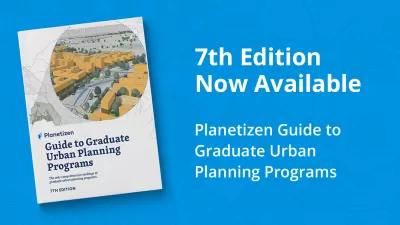Planetizen has a whole new look.

Planetizen has a whole new look and feel today, culminating hundreds of hours of work by our entire staff. We are excited to share this new website with our readers, and recommit to our mission as the independent resource for people passionate about planning and related fields.
The Planetizen relaunch is the third complete redesign since 2010, and we are of the opinion that the site gets more effective and fetching with every iteration. The changes you'll find on the site leverage the history of the site—the legacy of all the planning news, analysis, and resources gathered here since 2000—while responding to the rapid rate of change on the Internet.
Back in 2015—the last time we completely overhauled Planetizen—we celebrated the launch with an article explaining how the new design catered directly to specific user experiences. Much of that conceptual framework is still in place, with pages and resources organized according to specific uses of the site—e.g., staying on top of urban planning news, analysis, and commentary; discovering planning education opportunities and programs; improving jobs skills to advance careers in planning; and having a little bit of fun.
The New Planetizen Website
The highest purpose of Planetizen is to call attention to the aspirations and inspirations of a diverse and wide-ranging audience—urban planners, city planners, transportation planners, environmental planners, civic enthusiasts, students, and professionals from a multitude of related fields, among others.
To achieve that lofty goal, Planetizen has continued to refine the website to become a more useful and efficient source of information and resources—like a daily newspaper (classifieds included) for the world of planning. In this redesign, many of those changes can be found on the homepage, which we reorganized to show more articles at the top of the page and package related articles by topic (like the "Coronavirus and Urbanism" section featured on the homepage on redesign launch day). Each article now also includes links to related articles, because any one of these articles is usually just scratching the surface of a veritable ocean of knowledge and experience. Each article page also features a cleaner, two column design to reflect contemporary web design practices.
The changes you'll find on the site leverage the history of the site—the legacy of all the planning news, analysis, and resources gathered here since 2000—while responding to the rapid rate of change on the Internet.
Other avenues for exploration include new prominence and access to Planetizen Courses on the homepage. Planetizen Courses continues to be a growing and thriving component of the constellation of Planetizen products and services, and visitors will now be able to preview new and featured courses right there on the homepage.
The Technological Improvements Behind the New Planetizen Website
One of the key technological improvements that will benefit the editorial components on Planetizen is a complete overhaul of the design for AMP pages. AMP is the format designed for speedy delivery of websites on smartphones for Google searches and some social media platforms. Planetizen is now among a number of websites almost duplicating the design and functionality of their original website for AMP. These improvements should provide a powerful tool for reaching new audiences.
All of the design changes described above are empowered by the biggest change of all: an upgrade to Drupal 9—the newest version of the Drupal technology platform that has powered Planetizen since 2006. For the uninitiated, Drupal is an open source content management system that allows for easy, constant updates and content creation. Drupal 9 launched in 2020, promising more functionality for enterprise businesses in addition to a more intuitive user interface for Planetizen staff, bloggers, and contributors. This upgrade will improve performance and allows for the integration of other open source modules to extend the functionality of the website with relative ease. Finally, the Drupal 9 update also ensures that Planetizen is operating with best practices of Internet security—an absolute must in 2021.
Planetizen also accomplished a number of additional under-the-hood technological improvements, including:
Structured Data: A sizable percentage of Planetizen's traffic comes from searches on Google and Microsoft Bing for words and phrases related to urban planning. The use of structured data using the schema.org standard provides search engines with more, and more relevant, information about how the content on Planetizen might be useful to people using those search engines.
Google Tag Manager: Planetizen is a long-time user of the free Google Analytics reporting system for insight into how visitors are using Planetizen's websites. By implementing Google Tag Manager, Planetizen is empowering Google Analytics to more efficiently measure performance and traffic in addition to allowing non-web developer staff members to perform A/B testing using Optimizely. A/B testing is the process of showing two variants of the same web page to different segments of website visitors at the same time to collect information about which is more effective.
A Few More Details
On this big launch day, Planetizen is also announcing the launch of a new service called Planopedia. Since the beginning of 2020, Planetizen editorial staff—James Brasuell, Diana Ionescu, and Philip Rojc—have been creating Wikipedia-style articles that provide clear, authoritative definitions of some of the most essential and often misunderstood terms from the field of planning. Planopedia currently includes more than 40 entries, but Planetizen will continue to post more of these definitions every month to help bridge the divides of understanding between the public and the profession.
Planetizen achieved these improvements in partnership with the hard work and process of the designers and developers of Urban Insight. Urban Insight worked with Planetizen through a creative process to identify user needs and identify actionable design choices to help Planetizen achieve their goals. The Urban Insight creative process focuses on users, goals, and brand—principles embodied in the information architecture, organization, content hierarchy, and the overall visual design of the new Planetizen website.
The culmination of the project deserves the recognition of the whole team—and this was truly a team effort. Cate Miller managed the design and development of the new project; José Ramirez led the design work; Chris Steins provided leadership and direction for this project at the head of both Urban Insight and Planetizen; Ki Kim, Jay Lee, Gergely Lekli, and Lehel Mátyus did the development work; and Lee Flannery, Olga Serhijchuk, Cathy Hwang, and Diana Ionescu generated design ideas and tested the site on its way to launch. We'll probably be working out some bugs over the next few days, but we hope you have a chance to explore and enjoy more of the changes and new features on the Planetizen site soon and for a long time into the future.
All of these components—both visible and invisible—add up to big changes for Planetizen and our readers. There's a lot of work to be done, as always, and Planetizen is proud to be a partner in planning and building a prosperous future.

Planetizen Federal Action Tracker
A weekly monitor of how Trump’s orders and actions are impacting planners and planning in America.

Map: Where Senate Republicans Want to Sell Your Public Lands
For public land advocates, the Senate Republicans’ proposal to sell millions of acres of public land in the West is “the biggest fight of their careers.”

Restaurant Patios Were a Pandemic Win — Why Were They so Hard to Keep?
Social distancing requirements and changes in travel patterns prompted cities to pilot new uses for street and sidewalk space. Then it got complicated.

Platform Pilsner: Vancouver Transit Agency Releases... a Beer?
TransLink will receive a portion of every sale of the four-pack.

Toronto Weighs Cheaper Transit, Parking Hikes for Major Events
Special event rates would take effect during large festivals, sports games and concerts to ‘discourage driving, manage congestion and free up space for transit.”

Berlin to Consider Car-Free Zone Larger Than Manhattan
The area bound by the 22-mile Ringbahn would still allow 12 uses of a private automobile per year per person, and several other exemptions.
Urban Design for Planners 1: Software Tools
This six-course series explores essential urban design concepts using open source software and equips planners with the tools they need to participate fully in the urban design process.
Planning for Universal Design
Learn the tools for implementing Universal Design in planning regulations.
Heyer Gruel & Associates PA
JM Goldson LLC
Custer County Colorado
City of Camden Redevelopment Agency
City of Astoria
Transportation Research & Education Center (TREC) at Portland State University
Camden Redevelopment Agency
City of Claremont
Municipality of Princeton (NJ)





























